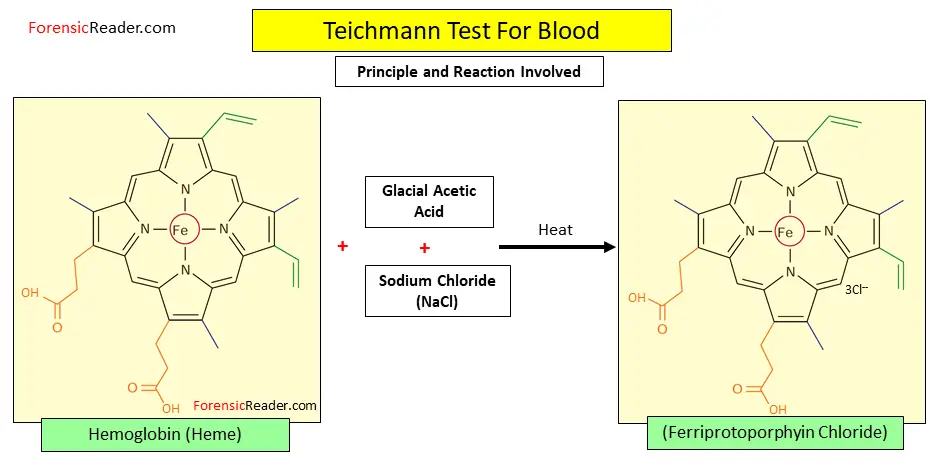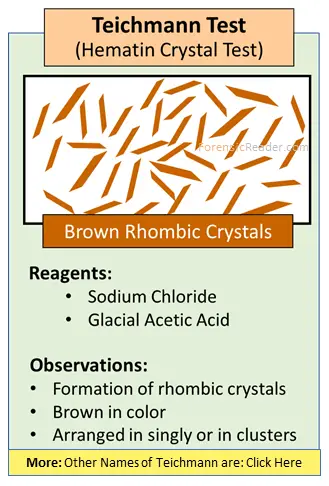Teichmann is a microcrystal confirmatory test for blood, used by forensic experts. It is also called Hemin or Hematin test. Its positive result is indicated by the formation of rhombic-brown crystals on the reaction of heme with salt and glacial acetic acid.
Who Developed Teichmann Test?
The test was first developed by Ludwik Karol Teichmann, a Polish anatomist in 1853.
He documented these microcrystals in his paper of 1853 and named them ‘Hematins’. But later, these crystals called to be Teichmann’s crystals.
What are Other Names of Teichmann Test?
It is called to be:
- Hemin Crystal Assay Test
- Hematin Crystal Assay Test
- Ferriprotoporphyrin Chloride Test
- Hematin Chloride Test
Principle of Teichmann Crystal Test
The test is based on the reaction of the heme part of blood with NaCl and glacial acetic acid to form brown-colored rhombic crystals. These prismatic-rhombic-shaped brown crystals are a sign of the formation of hematin chloride (ferriprotoporphyrin chloride) crystals.
Generally, a Hemoglobin has six binding non-proteinous sites. Four have nitrogen coordination bonding to tetrapyrrole ring with iron (Fe2+). While the fifth bonding is between the iron atom and nitrogen of the deprotonated proximal histidine residue. Lastly, it either has a water or oxygen bonding (oxygenated Hb).
When NaCl with glacial acetic acid reacts with heme, a heme derivative known as Hematin is formed with a central iron in the ferric state (Fe3+).
The following is the chemical reaction involved in the Teichmann Assay Test that results in the formation of Ferriprotoporphyin chloride crystals.

Reagents For Teichmann Test
There are two major reagents for this test.
- Glacial Acetic Acid
- NaCl crystals
Reagent Preparation: Take a small amount of NaCl crystal and add few drops of glacial acetic acid and mix well.
Also Read:
- Confirmatory Test for Blood: 7 Important Topics
- Takayama Test For Blood: Principle, Reagent, Procedure, Advantages, and Disadvantages
- Wagenaar Test: Procedure, Reagents, Forensic Importance, Pros, and Cons
- Tetramethylbenzidine (TMB) Test: Principle, Reagent and Procedure
Preparation of Teichmann Crystals (Procedure)
Follow the following points for the preparation of Teichmann crystals as the confirmatory test for blood.
- On a glass slide, take a drop of the suspected blood sample.
- Add a few drops of prepared reagent (NaCl and Glacial Acetic Acid).
- Cover the slide with a slip cover.
- Heat the slide over low flames for a few seconds.
- Observe under a standard microscope.
Observation of Hematin Test

Positive Teichmann Result: Confirmatory Blood Sample
- Formation of rhombic crystals, which are
- Brown in color
- Arranged in singly or in clusters
- Adding a few drops of hydrogen peroxide releases bubbles.
Negative Result: Following may be possible
- Blood is not present, or
- False-negative result (later in the post), or
- Other possibilities such as color dye or red paint.
If NOT Blood then What?: For that, you can use Phase Contrast Microscope.
- If normal red color: It has multicolored fragments (usually more than one color)
- If red paint: It has colorful and glossy crystals (majorly automobile color paint or metal paints).
False Negative Result in Hemin Test
Following are the reason for Teichmann (Hemin) false-negative test:
- Stain is old
- Stain is washed
- Treated by chemicals
- Not using conc. acetic acid
- Use of too much sodium chloride crystals
- Overheating (favorable temperature is 25°C to 62.5°C)
Note 2: Blood or bloodstains heated above the temperature of 140°C to 145°C will not yield any modified Teichmann microcrystal assays.
Advantages of Teichmann/Hemin Test
- Easy to perform.
- Only two sets of reagents are required.
- Various modified versions.
- Highly specific to blood.
- No false-positive result is seen.
Disadvantages of Hemin Test
- Not reliable for old stains.
- Higher chance of getting a false negative result than the Takayama Test.
Modified Version of Teichmann (Hematin) Test
Irrespective of their modified version, all produce the same rhombic microcrystals. The only difference is chloride (Cl–)is replaced by other halogens.
A. M.C. Hussons Halide Salts (1875)
Husson was entitled to the development of a modified version of the Hematin test. He uses bromide and Iodide salts for confirmatory detection of blood.
B. Nippes Modified Teichmann Test
In this modified version, instead of using a single salt, Nippe uses a combination of chlorides, bromides, and iodide salts. This reagent is called to be Nippes fluid consisting of 1% of KCl, KBr and KI dissolved in glacial acetic acid.
Please Note: In 1962, Fiori clarified and stated that there were no particular advantages to using any other halide salts other than sodium chloride in the Teichmann test as the confirmatory test for blood.
Test Your Knowledge
1. Hydrogen peroxide is used in all of the following tests, except:
- Teichmann’s
- Ortho toluidine
- Benzedine
- Phenolphthalein
2. Which of the following is the correct sequence of examination of an unknown bloodstain?
- Spectroscopic examination, Benzidine test, Hemochromogen test, Absorption inhibition
- Absorption inhibition, Benzidine test, Spectroscopic examination, Ring assay
- Kastle-Mayer test, Teichmann test, Oakley- Fulthrope method, mixed agglutination test
- Latte’s crust method, Absorption elution methods, Single diffusion assay, RNA-based assays
3. Which of the following is the right combination for producing hematin crystals?
- Glacial acetic acid and sodium chloride
- Glacial acetic acid and sodium iodide
- Glacial acetic acid and sodium bromide
- Both (1) and (2)
- All of the above
4. Match the following:
| List-I | List-II |
|---|---|
| (a) P-30 | (i) Urine |
| (b) Urea Nitrate Crystal Test | (ii) Saliva |
| (c) Starch Iodine Test | (iii) Seminal fluid |
| (d) Teichmann’s Test | (iv) Blood |
| (a) | (b) | (c) | (d) | |
|---|---|---|---|---|
| 1. | (iv) | (iii) | (ii) | (i) |
| 2. | (i) | (iv) | (ii) | (iii) |
| 3. | (ii) | (i) | (iii) | (iv) |
| 4. | (iii) | (i) | (ii) | (iv) |
5. What are the other names of Teichmann Assays Test?
- Hematin
- Hemin
- Ferriprotoporphyrin Pyridine Test
- Both (1) and (2)
- All of the above
References:
- Sourcebook in Forensic Serology, Immunology, and Biochemistry
- Anil Aggrawal, Essentials of Forensic Medicine and Toxicology
- Nordby, Forensic Science: An Introduction to Scientific and Investigative Techniques
- A note on a Modification of Teichmann’s Test for Blood [NCBI]
Continue Reading
- Confirmatory Test For Blood: 7+ Important Forensic Medicine Tests
- Orthotolidine Test (Kohn & O’Kelly test): Principle, Reagent And Procedure
- Cavett Test of Ethanol Estimation And Forensic Importance
- Development of Bloody Fingerprint: Chemical Test and Techniques
- 6 Tests to Solve Disputed Paternity and Maternity in Forensic Science Cases

FR Author Group at ForensicReader is a team of Forensic experts and scholars having B.Sc, M.Sc, or Doctorate( Ph.D.) degrees in Forensic Science. We published on topics on fingerprints, questioned documents, forensic medicine, toxicology, physical evidence, and related case studies. Know More.
